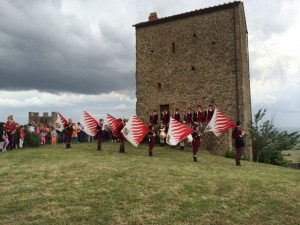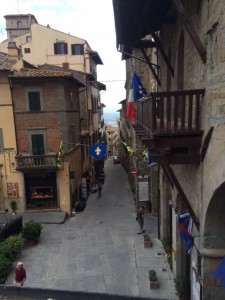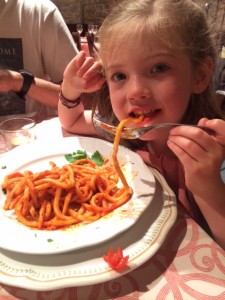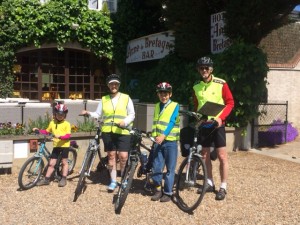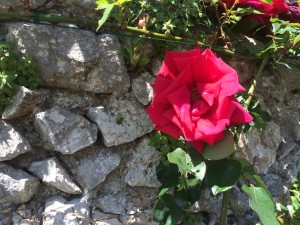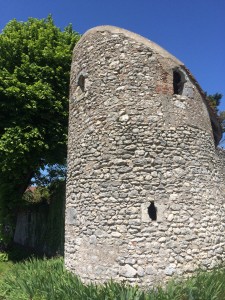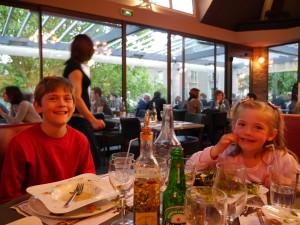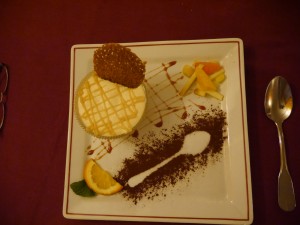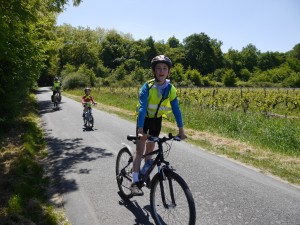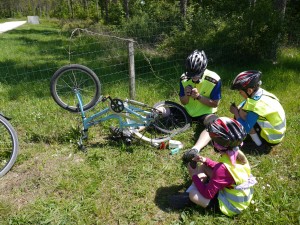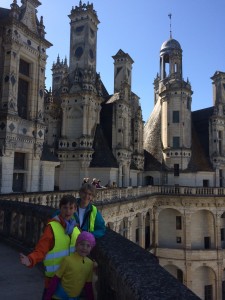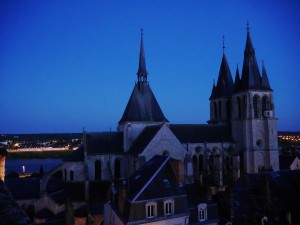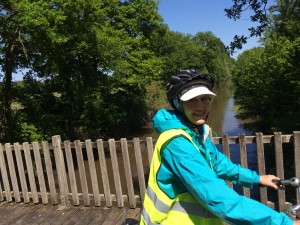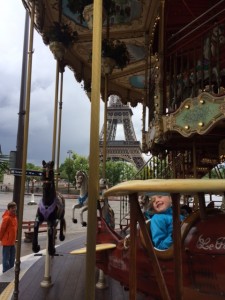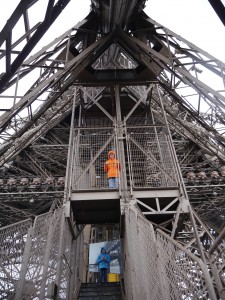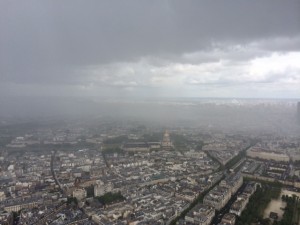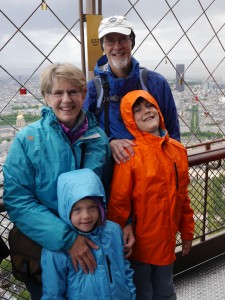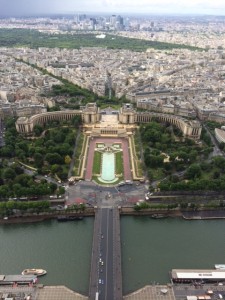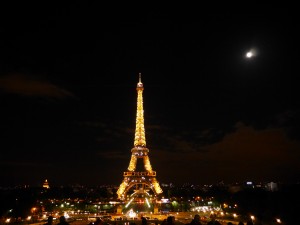This week, one more trip, this time north by way of Ravenna, to Venice, a unique experience in a unique city, including a hoped for tour of the famous glass works on the Island or Murano. Then, its ALL ABOARD once more, on the train bound for Rome.
Author Archives: Erik Kindem
On the pilgrims’ path in Tuscany: The Via Francigena
Walking on the Via Francigena from Gambassi Terme to San Gimignano.
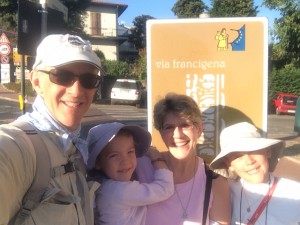 We awoke just before the sun first peaked above the eastern hills and quickly we made ready for our journey. The forecast called for mid-90 degree weather, and we knew that each moment the sun shone, the temperature would swiftly rise. Finally we got out the door about 6:45 and made it to Gambassi Terme a few minutes after 7am. The sign just outside the Church of San Maria a Chianni announced the Via Francigena, and off we went at 7:20am.
We awoke just before the sun first peaked above the eastern hills and quickly we made ready for our journey. The forecast called for mid-90 degree weather, and we knew that each moment the sun shone, the temperature would swiftly rise. Finally we got out the door about 6:45 and made it to Gambassi Terme a few minutes after 7am. The sign just outside the Church of San Maria a Chianni announced the Via Francigena, and off we went at 7:20am.
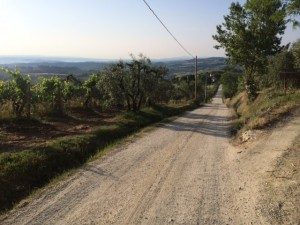 The first kilometer descends on twisting tarmac and we had to watch the road and traffic. It was a relief to leave that behind and to be on a farm road that descended gradually toward the valley below. A view of San Gimignano in the distance set the goal right before us. The air was still cool, and our spirits high. “Come walk with us the journey is long…” Naomi and I sang, as the road descended past vineyards and olive groves, enjoying the still and abundant beauty of the vistas, morning bird song, and the joy of the road.
The first kilometer descends on twisting tarmac and we had to watch the road and traffic. It was a relief to leave that behind and to be on a farm road that descended gradually toward the valley below. A view of San Gimignano in the distance set the goal right before us. The air was still cool, and our spirits high. “Come walk with us the journey is long…” Naomi and I sang, as the road descended past vineyards and olive groves, enjoying the still and abundant beauty of the vistas, morning bird song, and the joy of the road.
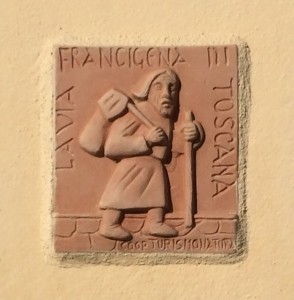 From the beginning the trail was well marked—something I’d hoped for and somewhat expected, but one never knows—besides, I’d left the map on the kitchen table and would have to depend on that signage even more so! Traveling with other pilgrims (most today spoke Italian) also allowed us to be more confident. But again, every fork in the road was well marked with V.F. or the pilgrim symbol and accompanying arrows and signs that made it abundantly clear where we were to walk.
From the beginning the trail was well marked—something I’d hoped for and somewhat expected, but one never knows—besides, I’d left the map on the kitchen table and would have to depend on that signage even more so! Traveling with other pilgrims (most today spoke Italian) also allowed us to be more confident. But again, every fork in the road was well marked with V.F. or the pilgrim symbol and accompanying arrows and signs that made it abundantly clear where we were to walk.
Along the way I talked about Archbishop Sigeric, the newly appointed bishop of Canterbury Cathedral, who had made this journey around 990 to Rome to receive his pallium from the Pope[1], and who kept a diary of his stops on his return journey—a diary which survived and is a unique document detailing the Via Francigena Road and the churches in existence along the road at that time. We imagined him sharing in the same vistas as we were—with changes, of course—traversing the same streams, and walking up and down the same valleys and hills. And not only him but the 1000’s upon 1000’s of pilgrims who likewise made this physical/spiritual journey over the last millennium, whether for practical reasons or with the expectation that they were on a journey with sacred dimensions.
For the first time since we left Canterbury I felt like we were pilgrims more than tourists; and I felt my heart growing lighter and fuller even while the temperature rose, knowing that together, as a family, we were in the act of fulfilling this long-held goal of walking a stage of the Via Francigena.
The map suggested this stage would be about a 3 hour journey covering 13.4 kilometers (8.33 miles), and I held an unexpressed hope that, for us, 4 hours would do it. Having attained the valley floor, we began ascending, thinking that over the next crest, we’d be rewarded with another view of San Gimignano, but that didn’t happen. We were, however, able to look backwards and to see from whence we’d come, and as Gambassi receded in the distance, we knew that each step was taking us closer to our goal.
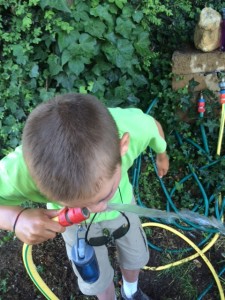
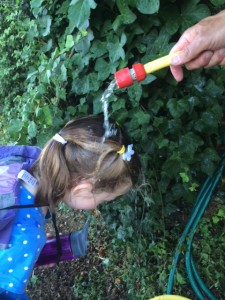 We passed wineries, small grottos set up to honor St. Mary for ancient or more contemporary appearances and interventions; places that, in some form or another, had been witnessing pilgrims’ journeys for the past 1000 years or more. At one place we found a hose and cold water awaiting us…reminding us of how God provided for the children if Israel during their long journey through the wilderness.
We passed wineries, small grottos set up to honor St. Mary for ancient or more contemporary appearances and interventions; places that, in some form or another, had been witnessing pilgrims’ journeys for the past 1000 years or more. At one place we found a hose and cold water awaiting us…reminding us of how God provided for the children if Israel during their long journey through the wilderness.
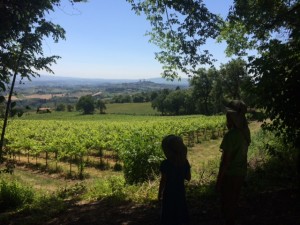 Finally, having come up a long, long stretch of uphill walking, including passing several swimming pools— pure torture!—the sight for which we had longed greeted us at last—San Gimignano’s towers were before us, now so much closer at hand. Still, looks are deceiving when traveling, and it was much further and took us much longer, than we expected before we would finally walk through SG’s great stone gates.
Finally, having come up a long, long stretch of uphill walking, including passing several swimming pools— pure torture!—the sight for which we had longed greeted us at last—San Gimignano’s towers were before us, now so much closer at hand. Still, looks are deceiving when traveling, and it was much further and took us much longer, than we expected before we would finally walk through SG’s great stone gates.
By now, it was well over 90 degrees. Kai walked with me for much of the second half of the journey, sometimes holding my arm, sometimes singing with me “the ants go marching…” and making up verses along the way, while Naomi walked with Chris. Naomi had found her rhythm and would swing both arms forward at once, somehow finding this a helpful strategy as we worked our way up the hills.
As we made it to the outskirts of San Gimignano traffic increased. There was a couple kilometer section where we had to be quite vigilant around curves. But finally, after the roundabout announced we were officially in town, we found firm and safer footage on the sidewalk, and began our the final ascent to the old city, hunting every slice of shade we could find, as our energies waned and the temperature continued to climb.
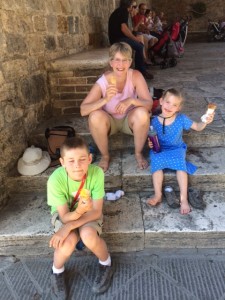 Once within the gates we stopped for water—AH! the indescribable sensation of rinsing off sweaty arms, hands and faces—and then followed the stone trail to the main plaza in the center of town, where we knew gelato awaited us. Where was that world famous gelato we’d had a taste of two days before?!
Once within the gates we stopped for water—AH! the indescribable sensation of rinsing off sweaty arms, hands and faces—and then followed the stone trail to the main plaza in the center of town, where we knew gelato awaited us. Where was that world famous gelato we’d had a taste of two days before?!
After a 7:20am start, it was now 12:30pm. Our journey from Gambassi Terme had taken just over 5 hours. And as we ate our treats at last we rested in the shade and discussed our next move. (for the record, Erik and Kai both had mango and fragola, Naomi had chocolate and mango, and Chris had all Michell, a flavor she’d discovered a couple days earlier, which combined orange peel, saffron, honey, and almonds). Soon we were back at Poggio ai Chieli, our Agriturismo farm near Ulignano, enjoying the pool and the deep satisfaction of knowing that we’d had a wonderful, challenging, and rewarding journey that gave us as a family a taste of the pilgrim’s road.
Why pilgrimage? I always think better when I’m on my feet. The noise of thoughts gradually falls away, my head clears. The physical act is in line with what the human body was designed to do: walk. But the pilgrim’s journey is spiritual as well as physical. One is called to live in the current moment, to experience what the road brings in terms of nature’s gifts, vistas, insights, discoveries, challenges. As the clutter falls away, one’s soul opens to a deeper dialog with oneself and with the Divine.
Being on the pilgrim road puts me in the company of other pilgrims–both ancient and contemporary–and the sense of community it commends—whether or not one has named companions. It is a journey toward transformation. As we journey from one hill town to another, this sense of community is also enlarged by offers of hospitality and welcome, and the promise that unexpected gifts and graces will be received.
When we started our walk at San Maria a Chianni in Gambassi, we gathered in a circle and prayed that our journey would be marked by joy and kindness, and that our eyes would be opened to see things around us. I’m so grateful to say that this, indeed, was our experience. I’m so proud and thankful for the way our children—indeed each of us—trekked those 13+ kilometers in rising heat without complaining or getting cross, but with humor and with a sense of community. Via con Dios…we go with God.
[1] The pallium is an ecclesiastical vestment in the Roman Catholic tradition bestowed by the pope on bishops and archbishops as a symbol of the jurisdiction delegated to them by the Holy See.
June 1-15
June begins with a four-day sojourn in Florence, cultural capital of the Renaissance. Then it’s off to a second agriturismo, this located outside of San Gimignano. Here we reconnect with the Via Francigena pilgrimage route to Rome, and will take walks from one small village to the next, while spending nights at another Italian farm, Podere Poggio ai Cieli. Leaving the farm on June 12th, we head northwest to the Italian coast, via Pisa, Lucca, and the Cinquiterra.
Bella Italia (by Kai and Naomi)
We’ve made it to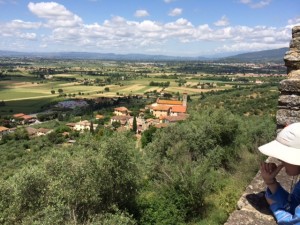 Italy! And are truly enjoying the incredible dulce vita of Tuscany. We’re staying at the agriturismo working farm of Alberto and Roberta Bennati outside of Castiglion Fiorantino.
Italy! And are truly enjoying the incredible dulce vita of Tuscany. We’re staying at the agriturismo working farm of Alberto and Roberta Bennati outside of Castiglion Fiorantino.
Kai: I’ve noticed lots of encounters with most drivers in Italy are a bit dangerous. This was especially true in Florence (Firenze). But where we’re living is nice and quiet. Our hosts own 12 horses, one donkey (assino), one cow which is going to have a calf in 6-7 days, chickens, rabbits, pigs, and sheep. They also have two nice dogs; Dado is my favorite, and I love to scratch his back and tummy.
Naomi: They also have a kitty. I really liked our horsey ride today. I rode on Amour, Kai rode on Armando, and Mommy rode on My Lady. It was my first time riding a horse all alone by myself.
Kai: The horse ride was quite nice, though at times Armando stopped to eat some grass. But I got used to getting him going again, and one time I nearly got to galloping.
There’s a really nice soccer field and a natural, spring fed pool, which does occasionally attract frogs. At first I didn’t quite want to go in, but after I saw other kids going in it, I said, “Hey, I want to go swimming!”
Naomi: The water is very cold. I can’t reach the bottom.
Kai: We got to go to a really, really cool castle (Castello di Montecchio) that someone actually lives in (learn more about it HERE). You can see it from the farm. We met a woman named Xenia who’s making a film about the castle. She gave us a tour. The castle is marking its 1,000 year birthday this year.
Naomi: Yesterday we went to Cortona, and had two flavors of gelato with two round cookies sticking up like Mickey Mouse ears. The city is built on a hill, and we hiked to the top of the steep streets and could see for miles across the great valley (Val di Chiana).
Tonight we’re helping to make pizza with Roberta.
‘
May 24-31
This week marks the transition from France to Italy. We travel via train from southern France to Tuscany, province of Arezzo, where we begin a weeklong stay at a working Italian farm (agriturismo) near Castiglion Fiorentino, in the Arezzo region of Tuscany. The farm will be our home base for their first week in Italy. Day trips to nearby Assisi, home of St. Francis, as well as Siena are planned.
Cycling in the Loire Valley
We have had three spectacular days riding on cycling paths and rural roads under sunny skies in the Loire Valley. With Blois as our starting and ending point, we pedaled through the valley enjoying prolific birdsong, small unmapped villages, incredible histories of 16th century chateaux of the region, so memorable surprises, and unbelievable meals.
Route-finding was not always as easy as we would have liked–in spite of maps and a detailed itinerary–but we had some incredible experiences; some of which were planned and many which were not. All told we biked about 55 miles in three days, each one of us on his/her own bike, and the kids did remarkably well. Below and on our photos page are a sampling of some photos from along the way.
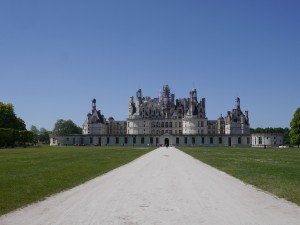
Chateau Chambord, largest in the Loire valley, has a central staircase and floor plan thought to be designed by Leonardo DaVinci. Like a number of sites, it was in the process of restoration through a national French cultural preservation program.
Loire Valley Bike Trip Photos
May 18-23
From May 18 – 23 the schedule is loosely defined. A stop at Le Chambon-sur-Lignon is planned, and Erik plans to rent a road bike for two days of more robust cycling along roads made famous by the Tour de France.
The story of the small of Protestant Huguenot farming village of Le Chambon in the mountains of south-central France is compelling. When France capitulated to Germany in June of 1940, the fate of French citizens and foreigners of Jewish ancestry was in doubt. That very day, Pastor Andre Trocmé stood in the pulpit of his parish church to address his parishioners in Le Chambon:
“The responsibility of Christians is to resist the violence that will be brought to bear on their consciences, through the weapons of the spirit.”
Over the course of WW 2, the approximate 5,000 inhabitants of that valley and surrounding areas sheltered approximately 3,500 Jewish men, women, and children (in addition to 1,500 others) in direct opposition to the orders of the French Vichy government and Nazi occupation forces, for the duration of the war. When Vichy authorities demanded that Pastor Trocmé cease his activities, he told them:
“These people came here for help and for shelter. I am their shepherd. A shepherd does not forsake his flock. I do not know what a Jew is. I know only human beings.”
Eventually, Trocmé was forced to hide from the Nazis. But his wife continued his legacy and with the aid and encouragement of local residents many Jews resided in relative calm until the end of the war. This story is powerfully documented in the film by Pierre Sauvage Weapons of the Spirit. (Sauvage was born in Le Chambon and returned years later as an adult to try to understand what happened here and why. Follow this LINK to view his interview with Bill Moyers about the film.)
Just before beginning my sabbatical, I (Erik) had the good fortune to exchange emails with Patrick Henry of Whitman College, a Holocaust scholar, who put me in touch with Nelly Trocmé Hewett, daughter of Andre and Magda Trocmé. (How we got to that point is itself a story that I’ll tell more of some day.) She told me of the existence of a new museum in Le Chambon, ( I thought they’d all closed), dedicated last summer (2013) that tells the story of what happened here. Her words, received only days before we began this trip, made the prospect of being in Le Chambon infinitely more meaningful. Le Chambon was not alone in its righteous conduct during that trying time. A dozen or so communities small communities of the region shared in the ministry of sheltering Jewish refugees, at the risk of their own lives, thus embodying Jesus’ admonition, “Love your neighbor as your self.”
__________________________
Following our time in Le Chambon, we will travel south to Arles and use it as a home base for experience the history and culture of the Provence region before heading on to Italy.
May 14-17
Leaving Paris on the 14th, we stop at the Cathedral at Chartres, to experience this medieval masterpiece and its famous labyrinth. Then it’s on to Blois for a four-day family cycling adventure among the châteaux’s of the Loire Valley, including one, Château de Cheverny, which was the inspiration for Captain Haddock’s country house in The Adventures of Tintin, by Belgian author Hergé; a series beloved both by Kai and his elder brother Nathan.
Paris High
TOP FIVE WORST PLACES TO BE IN A THUNDERSTORM…
5. In Lady Liberty’s torch
4. Atop London’s Big Ben
3. At the summit of Iona’s Dun’I
2. In the bell tower of Durham Cathedral
1. At the top of a 1,063 foot metal structure in Paris
Today some of our most deeply held sabbatical wishes were fulfilled—though it didn’t start out that way. After a late start, we stopped by the Luxembourg Park play area in our neighborhood, only to discover that we would be denied entrance once again to the special children’s play area we had been hoping (especially the youngest among us) to enjoy, this time due to maintenance work being performed. After some tears of disappointment, I suggested we head to the Eiffel Tower, a surefire success, and so we did. We found our way on the Metro to Tracadero Station, and emerged to get our first full scale view of the Tower…WOW!
It may seem to be almost a cliché, but there really is a reason this “temporary tower,” built during the Industrial Revolution to showcase the possibilities of building with steel, has maintained its iconic status—not only for Parisians but for the million visitors who come here each year from around the world.
After initial photo ops, and a stop for a carousel ride, we arrived at the Tower’s base at a moment when there were no crowds—likely due to the day’s on again, off again, rainy weather. We opted to climb the 700 stairs to the first level, then added the 952 stairs to the second. Then, finally, we decided to head for the top via the elevator—our only option. We conferenced about this before making our final move to the top, because one of the kids’ dreams was to see the Eiffel Tower at night. Having gone part way up, we decided we’d go up all the way while it was day so we could gain the full view of the city in the daylight, and we were rewarded with a lively experience, to say the least!
We saw, and then experienced, waves of rain squalls sweeping across the city. It made the experience more memorable—especially the hail! Our excitement multiplied several fold when peals of thunder and flashes of lightning (!) accompanied our time at the top observatory!
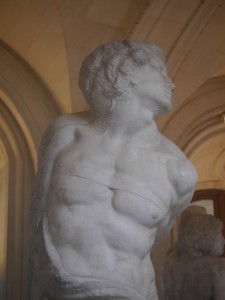 Following that “high” we hopped the Metro for the Louvre (the only museum open in Paris on Mondays.) Though we hardly had time to see much, we did visit Leonardo’s famous lady, saw some other treasured Renaissance paintings, and took in some of Michelangelo’s sculpture, namely, two statues (“Slaves”) that inspired Paris sculptor Auguste Rodin, whose work we’d seen on our first full day in Paris.
Following that “high” we hopped the Metro for the Louvre (the only museum open in Paris on Mondays.) Though we hardly had time to see much, we did visit Leonardo’s famous lady, saw some other treasured Renaissance paintings, and took in some of Michelangelo’s sculpture, namely, two statues (“Slaves”) that inspired Paris sculptor Auguste Rodin, whose work we’d seen on our first full day in Paris.
Finally, it was time to head to our flat for some dinner, and though we were pooped, Kai reminded us of our plan—and his and Naomi’s dream—of seeing the Eiffel Tower at night. So, after a later dinner, a bit of down time, and a change to warmer clothes, we took to the Metro once more and headed back to Eiffel. We were not disappointed.
Our first view of the lit tower, just before 11:00pm, was breathtaking, rising with elegant strength— and seemingly lit up from within—under now clear skies and a nearly full moon.For the first 5 minutes of every hour, in addition to the fixed lights, the Eiffel Tower glistens with flashing lights spread throughout its full height. So five minutes after arriving, we saw the Tower in all its glistening brilliance!
“This is a midsummer night’s dream,” said Kai to Chris, as we took in a site that had been right at the top of hoped-for sabbatical experiences. Oo-la-la!

